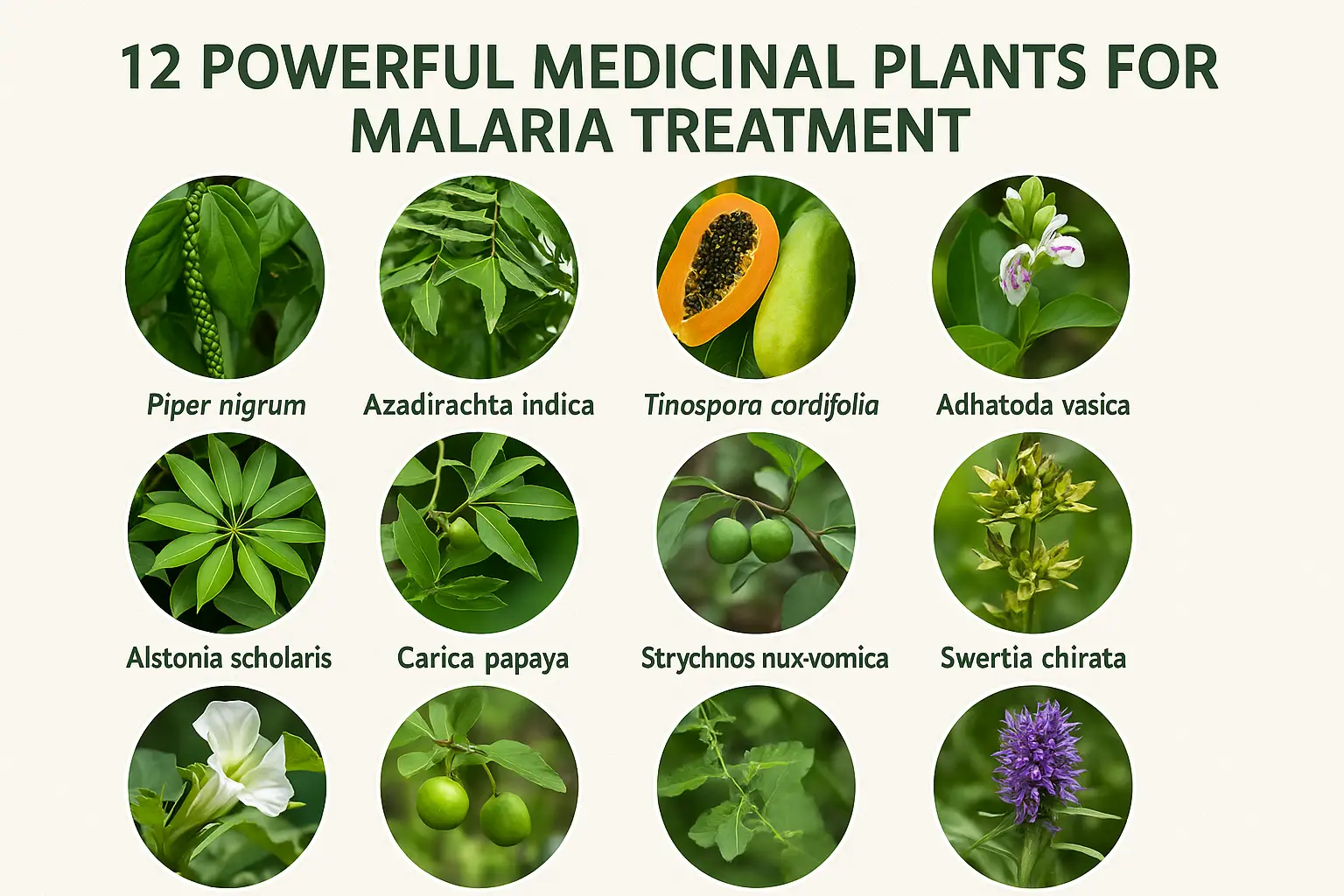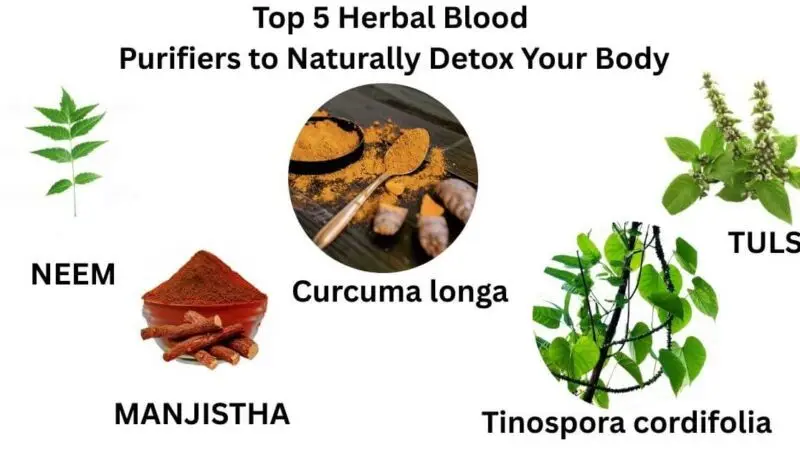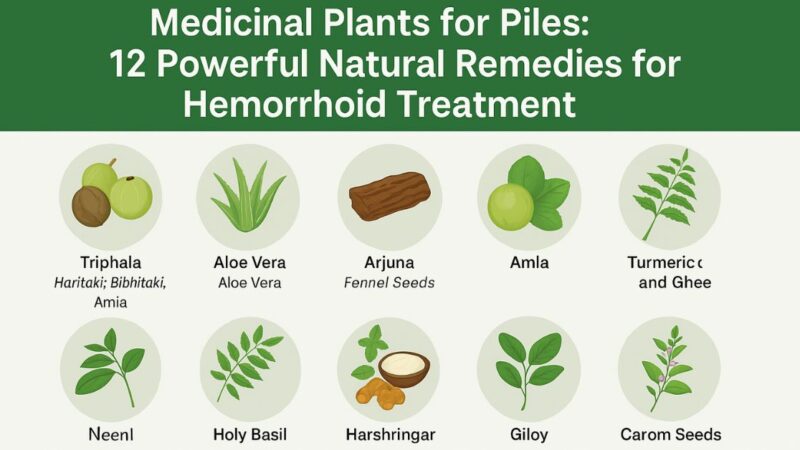12 Powerful Medicinal Plants for Malaria Treatment – Rajkumar Logre

🌿 Introduction: Understanding Malaria and the Role of Medicinal Plants
Malaria isn’t just another fever—it’s a deadly parasitic disease that still affects millions around the globe.It is carried by the bite of a mosquito with Anopheles infections and is brought on by the Plasmodium parasite. Regular fever, chills, sweating, headaches, and exhaustion are among of the symptoms of this condition, which is common in tropical and subtropical areas. If not treated in time, malaria can become severe, leading to organ failure or even death.
What makes malaria a complex challenge is that the parasite has developed resistance to several drugs over time. This growing resistance has led scientists and traditional healers alike to look back at nature’s pharmacy: medicinal plants. For centuries, communities across Asia and Africa have relied on herbal remedies to combat malaria. These plants not only help reduce fever and control symptoms, but many of them also strengthen the immune system, cleanse the blood, and help the body recover faster.
🌱 Ethnobotanical Importance: Why Medicinal Plants Still Matter
The study of how indigenous civilizations use plants for spiritual, dietary, and medical purposes is known as ethnobotany. In the case of malaria, such knowledge passed down through generations has identified certain herbs and shrubs as effective in treating the disease. These remedies aren’t just based on folklore; many of them are now being validated by modern science.
In traditional systems like Ayurveda, Unani, and Siddha, specific plants are classified based on their therapeutic actions—some reduce fever (jwaranashak), some detoxify the body, and others enhance immunity. These healing strategies are holistic, meaning they don’t just attack the parasite but help the entire body regain strength.
Here’s why these traditional herbs matter:
-
Cost-effective: Herbal therapies are often less expensive than prescription drugs.
-
Accessible: Available even in remote rural areas.
-
Fewer side effects: When used correctly, they tend to have fewer complications than synthetic drugs.
-
Sustainable: Encourages biodiversity and sustainable harvesting practices.
What makes this even more intriguing is how many of these plants are already part of our daily lives. Think of tulsi, neem, and papaya—easily available and widely used. The secret lies in knowing how to use them the right way.
Let’s dive deeper into these medicinal marvels and see how each plant contributes to the battle against malaria.
🌶 Piper nigrum (Black Pepper): A Fiery Fighter Against Fever
Black pepper is a secret kind of medicine, not just a spice. Used extensively in Ayurvedic formulations, Piper nigrum holds a warm, sharp flavor that packs not just culinary value but significant therapeutic benefits. For malaria, it’s especially known for its role in reducing fever and revitalizing the body’s energy levels.

How Does It Work?
Black pepper contains piperine, a bioactive compound that enhances the absorption of other nutrients and medicines in the body. This means that if you’re taking herbal or allopathic treatment, black pepper can make it work better. When you’re dealing with malaria, every bit of support counts.
-
Reduces Fever: Its warming effect helps regulate body temperature and break the fever cycle.
-
Boosts Metabolism: Helps the body process food and medicines more effectively, crucial during recovery.
-
Energizes the Body: Its stimulating properties help counteract the fatigue and weakness that comes with malaria.
Usage in Traditional Medicine
In traditional remedies, black pepper is often combined with honey, tulsi leaves, or turmeric to form a paste or decoction. Taken twice daily, it can provide much-needed relief, especially during the initial phases of the infection.
But watch out—too excess black pepper might cause irritation to your gastrointestinal lining. Moderation and balance are key. If you’re using it as part of a herbal protocol, it’s best to consult an Ayurvedic practitioner to ensure correct dosage and combinations.
🌿 Azadirachta indica (Neem): The Bitter Healer
Neem is a household name in Indian medicine. This tree, well-known as the “village pharmacy,” is valued for its potent antiviral, antibacterial, and antiparasitic qualities. When it comes to malaria, neem is one of the top traditional go-to remedies.
Why Neem is Effective
Neem contains a variety of active compounds like azadirachtin, nimbin, and nimbidin which exhibit antimalarial activity. These compounds not only inhibit the growth of Plasmodium parasites but also purify the blood, reducing the overall toxin load on the body.
-
Kills Parasites: Directly targets malaria-causing pathogens.
-
Purifies Blood: Enhances liver function and detoxifies the bloodstream.
-
Boosts Immunity: Strengthens the body’s defense mechanisms.
Traditional Preparation and Use
Usually, neem leaves are utilized in crushed, juiced, or extract form. In many civilizations, it has long been customary to drink neem water on an empty stomach. Some also use neem oil or neem bark in external applications to soothe malarial rashes and reduce itching.
However, neem is extremely bitter and strong in nature, so it should be used carefully, especially for children or pregnant women. When used correctly, it serves as a potent antimalarial agent and a natural immune booster.
🌿 Tinospora cordifolia (Giloy): The Immunity Powerhouse
Giloy, also known as Guduchi in Sanskrit, is often called the “root of immortality.” And it’s not an exaggeration—this climbing shrub has some seriously impressive healing abilities, especially when it comes to infectious diseases like malaria.
What Makes Giloy So Special?
Giloy contains compounds like tinosporin, cordifolioside, and berberine, which help modulate the immune system and fight infections. In malaria treatment, giloy doesn’t directly kill the parasite but prepares your body to do it more effectively.
-
Strengthens Immunity: Helps white blood cells fight off the infection.
-
Reduces Fever: Has proven antipyretic (fever-reducing) effects.
-
Liver Protection: Detoxifies and protects the liver, which is often stressed during malaria.
How It’s Traditionally Used
The most resilient component of the growth is the root system. It’s boiled in water to make a bitter decoction or consumed as juice. Modern herbal supplements also offer giloy in tablet or capsule form.
It’s safe for long-term use and is one of the few herbs that Ayurvedic doctors recommend for everyday immunity. A mixture of giloy is tulsi flowers as well as black pepper works very well for malaria.
🌿 Alstonia scholaris (Saptaparna): The Bark of Health
Often referred to as the “Devil’s Tree” in folklore, Alstonia scholaris, or Saptaparna, is anything but evil in the world of medicine. Known for its incredibly bitter bark, this tree has earned its reputation as a powerful traditional remedy, particularly effective in treating fevers like malaria.

Why Is It Used in Malaria Treatment?
Saptaparna’s bark contains alkaloids such as echitamine, which possess strong antimalarial and anti-inflammatory properties. While modern pharmaceuticals isolate and amplify certain compounds, Saptaparna is used in its natural form to provide holistic support.
- Antipyretic Effect: Controls high body temperatures.
- Parasite Resistance: Weakens the Plasmodium lifecycle.
- Body Rejuvenation: Aids recovery by revitalizing energy and organ functions.
How Traditional Healers Use It
In many parts of India and Southeast Asia, the bark is dried and ground into a powder or boiled to extract its essence. This decoction is taken during malarial episodes, especially when fever spikes in cycles. Because of its bitterness, it’s sometimes mixed with sweeteners like honey or jaggery.
Although very effective, it should not be consumed in large quantities. Overdosing may lead to stomach issues or even toxicity. Therefore, it’s best taken under guidance.
🍃 Carica papaya (Papaya): The Platelet Booster
You might think of papaya as just a tropical fruit, but it’s actually one of the most celebrated natural remedies in treating not only dengue but also malaria. While it doesn’t directly attack the malaria parasite, its real value lies in restoring the body’s energy and increasing platelet count—something that plummets during malaria.
Key Benefits in Malaria
Papain, flavonoids, and phenolic acids are just a few of the bioactive substances found in papaya leaves. These aid in the synthesis of platelets, cellular healing, and general detoxification.
- Increases Platelet Count: Especially useful during or after infection when blood cells are damaged.
- Reduces Fatigue: Helps restore energy levels, which dip drastically during malarial bouts.
- Digestive Support: Enhances digestion, helping the body absorb other medicines and nutrients effectively.
Traditional Uses
The most common remedy involves crushing papaya leaves to extract juice and drinking it on an empty stomach. Though bitter, this juice has shown significant results in many clinical and anecdotal cases. Papaya fruit itself is often recommended during recovery because it’s light, easy to digest, and packed with vitamins.
However, pregnant women should consult a doctor before using papaya leaf juice, as its enzymes can stimulate uterine contractions.
🌿 Adhatoda vasica (Adusa): The Lungs’ Best Friend
When malaria hits, it’s not just fever and chills that take a toll—respiratory issues like coughing and congestion also become common. That’s where Adhatoda vasica, known as Adusa or Vasaka, becomes highly valuable.
Healing Powers in Malaria
Adusa is packed with alkaloids like vasicine, which have bronchodilatory and anti-inflammatory effects. It helps ease breathing, clear mucus, and control fever, making it perfect for those with respiratory distress during malaria.
- Clears Respiratory Pathways: Helpful when malaria brings about a cough or breathlessness.
- Reduces Fever: Acts as a mild antipyretic.
- Anti-inflammatory Agent: Calms inflamed tissues, both internally and externally.
Traditional Applications
In Ayurvedic practices, the leaves are boiled and the decoction is consumed twice daily. Sometimes, a syrup made from the extract is used, particularly in children. Additionally, honey is used to help ease the throat.
While generally safe, excessive consumption may cause irritation or allergic reactions. Always ensure proper dosage and usage under supervision, especially if combined with other treatments.
🌿 Datura metel (Dhatura): A Dangerous Ally
Datura, also known as Dhatura, is one of those plants that toe the line between poison and medicine. Used traditionally in malaria treatment, it requires extreme caution due to its potent and potentially toxic nature.

What Makes Dhatura Effective?
Datura contains alkaloids like atropine, scopolamine, and hyoscyamine—powerful substances that can affect the nervous system. These compounds, in small and controlled amounts, have been used to reduce fever and manage symptoms of malaria.
- Strong Antipyretic: Effective against high-grade fevers.
- Pain Relief: reduces joint and body pain brought on by malaria.
- Neurological Sedation: Helps manage restlessness and insomnia during infection.
Traditional Use & Risks
Only trained herbalists or Ayurvedic practitioners should handle Dhatura. Typically, its leaves or seeds are used in extremely diluted forms, often mixed with other herbs to reduce toxicity. It is never recommended for self-medication.
Incorrect dosage can lead to serious complications such as hallucinations, arrhythmia, or even death.It is the perfect example of nature’s two-edged sword: strong and dangerous.
🌱 Strychnos nux-vomica (Kuchla): Handle With Care
Kuchla is another controversial herb in traditional medicine. It’s derived from the seeds of Strychnos nux-vomica and is known for containing strychnine—a compound that is poisonous in high doses but medicinal in micro amounts.
Potential Uses in Malaria
Despite its toxic nature, when processed correctly and administered under expert care, Kuchla can be used to manage chronic fever and stimulate the nervous system.
- Reduces Fever: In very small doses, it helps regulate body temperature.
- Restores Strength: serves as a stimulant and is beneficial for severe post-malaria exhaustion.
- Pain Management: Helps relieve muscular and joint pain.
Traditional Methodology
Kuchla seeds are detoxified by soaking and boiling multiple times, then ground into powder. It’s used in formulations by expert practitioners in Unani and Ayurveda.
NEVER use it without proper supervision. Convulsions, nervous system failure, or even death can result from even a small overdose. It’s only meant for very specific conditions and under clinical observation.
🌿 Swertia chirata (Chirayata): The Natural Antipyretic
Swertia chirata, commonly known as Chirayata, is a herb celebrated in traditional Indian medicine for its powerful antipyretic and detoxifying effects. It’s a go-to remedy in rural areas for treating malarial fever, thanks to its ability to reduce body heat and combat infections naturally.
Medicinal Properties and Uses
Chirayata contains several potent compounds, such as swertiamarin, amarogentin, and mangiferin, which have been scientifically validated for their antimalarial and anti-inflammatory benefits.
- Fever Control: Known for rapidly reducing high fevers, making it highly effective during acute malaria episodes.
- Digestive Health: Supports digestion, especially useful when appetite is lost during fever.
- Liver Detox: Promotes liver function, aiding in toxin elimination post-infection.
Traditional Usage Methods
Chirayata is used as a bitter infusion in Ayurveda. A teaspoon of dried leaves is boiled in water and consumed two to three times a day. Despite its intense bitterness, it’s a reliable remedy for febrile conditions, especially when combined with tulsi or neem.
This herb is generally safe, but due to its bitterness and potency, it should not be consumed in excessive quantities. Those with low blood pressure should consult a physician before use, as Chirayata may cause a further drop in BP levels.
🌿 Ocimum sanctum (Tulsi): The Sacred Shield
No discussion of traditional healing would be complete without Tulsi, also known as Holy Basil. Worshipped in many Indian households, Tulsi is not just a spiritual plant but a medicinal powerhouse known for its adaptogenic and antimalarial effects.
Health Benefits for Malaria Sufferers
Tulsi is rich in essential oils and bioactive compounds like eugenol, ursolic acid, and rosmarinic acid. These components help in fighting infections, reducing inflammation, and repelling mosquitoes.
- Mosquito Repellent: Emits a strong scent that naturally keeps mosquitoes at bay.
- Fever Reducer: A natural antipyretic, helping to bring down fever without synthetic drugs.
- Immune Booster: Enhances the body’s resistance to infections through its adaptogenic properties.
Usage Across Households
The most common way Tulsi is used for malaria is by boiling fresh leaves with black pepper and ginger to create a decoction. Two or three times a day, this is taken. In contemporary herbal medicine, tulsi tea, pills, or tinctures are also widely used.
Long-term use of tulsi is harmless, and in diluted form, it is even appropriate for youngsters. Its accessibility and multi-functional benefits make it one of the best natural defenses against malaria.
🌿 Phyllanthus niruri (Bhui Amla): The Fever Tamer
Commonly known as Bhui Amla or Stonebreaker, Phyllanthus niruri is another underrated yet highly effective herb for managing fever and inflammation caused by malaria. It’s particularly beneficial in cases where the infection affects the liver and causes prolonged fatigue.
Key Healing Properties
Bhui Amla contains a wealth of phytochemicals including lignans, flavonoids, and tannins that have antiviral, antipyretic, and hepatoprotective actions.
- Reduces Body Heat: Helps cool the body and bring down persistent fever.
- Protects the Liver: Detoxifies and restores liver function often compromised during infection.
- Eases Inflammation: Soothes internal irritation and aids faster recovery.
Traditional Application
Bhui Amla is typically used in the form of juice or a water decoction made from fresh leaves or whole plants. It’s a gentle herb and generally safe, even for extended use, which makes it ideal for chronic sufferers.
Its natural cooling effect is also useful for those who experience recurring bouts of heat or sweating during malaria episodes. However, it should be used with caution in individuals prone to hypotension or cold-related ailments.
🌿 Picrorhiza kurroa (Kutki): The Liver’s Best Friend
Kutki is one of the most revered herbs in Ayurveda, particularly for its liver-cleansing and fever-reducing capabilities. In the context of malaria, Kutki plays a critical role in helping the body recover after the infection, especially if the liver has been affected.
Why Kutki is Crucial Post-Malaria
Kutki contains kutkin, picroside I and II, which are known for their hepatoprotective and antipyretic properties. These compounds not only reduce fever but also prevent liver damage and support its regeneration.
- Liver Protection: Shields and heals liver cells damaged by malaria or medications.
- Fatigue Recovery: Helps in the overall restoration of strength and energy.
- Immunity Support: Boosts resistance against recurrent infections.
How to Use Kutki
Traditionally, Kutki root is powdered and mixed with honey or warm water to be taken twice daily. It’s extremely bitter, but this very bitterness is believed to activate digestive and detoxification processes in the body.
Because of its potency, Kutki should not be taken in very high doses or over an extended period without guidance. Those with underlying liver conditions or pregnant women should only use it under professional supervision.
❓ FAQs
1. Can I take these herbal remedies alongside modern malaria medicines?
Yes, many herbs like giloy and tulsi can complement modern medicine. However, always consult a healthcare professional to avoid any adverse interactions.
2. Are these remedies safe for children?
Some herbs like tulsi and papaya are generally safe for children in diluted forms. Toxic herbs like Dhatura and Kuchla should be strictly avoided unless under expert care.
3. How long should I use these herbs during a malaria episode?
Typically, these herbs are used throughout the fever period and a few weeks after recovery to boost immunity and restore energy. Follow expert recommendations for duration.
4. Can I prevent malaria using these plants?
Yes, plants like neem, tulsi, and giloy can strengthen the immune system and repel mosquitoes, offering preventive benefits.
5. Where can I source authentic medicinal herbs?
Purchase from reliable local herbalists, accredited Ayurvedic retailers, or trustworthy internet sites. Before using herbs, always make sure they are authentic and of high quality.






